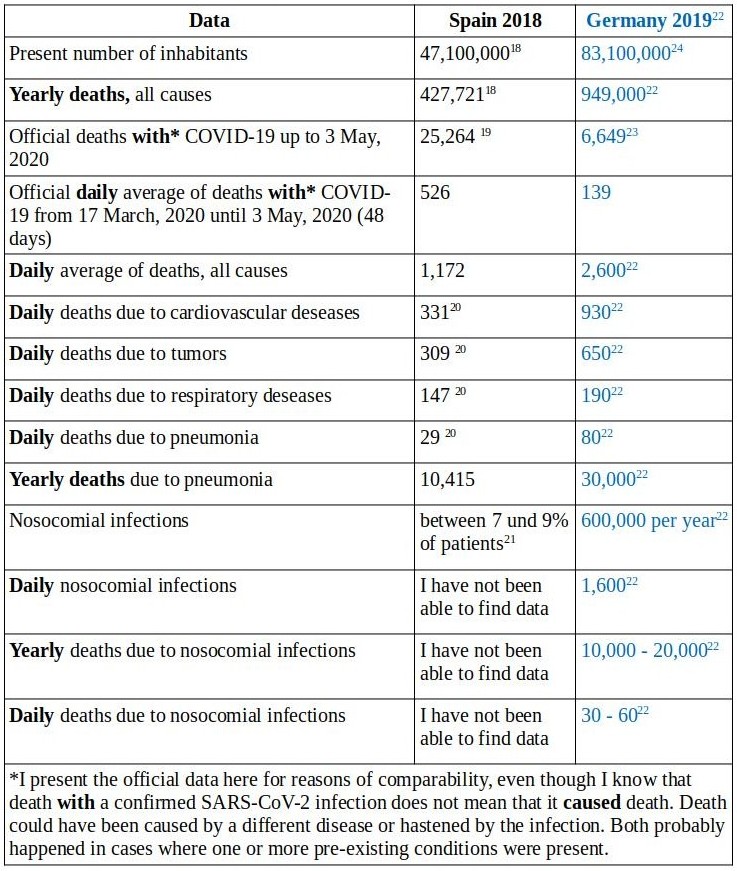"Everyone has the right to clear, accessible, timely and meaningful
information about the nature and extent of the threat to their
health".
(Esteban Beltrán, Director of Amnesty International's Spanish
Section, before the Economic and Social Reconstruction Commission of the
Spanish Parliament, European Union Group, 12 June 2020)
18: Instituto Nacional de Estadística: https://www.ine.es/,
accessed 29/04/2020. https://www.ine.es/dyngs/INEbase/es/operacion.htm?c=Estadistica_C&cid=1254736177008&menu=ultiDatos&idp=1254735573002.
19: https://covid19.isciii.es/,
accessed 03/05/2020.
(Update 27/06/2021: The URL now is:
https://cnecovid.isciii.es/covid19/)
20: https://www.ine.es/jaxiT3/Tabla.htm?t=14819
21: Regarding hospital germ infections in Spain, Informe global de
España, Resumen, Análisis EPINE-EPPS 2017 (313 hospitales y 61.673
pacientes), 9 Noviembre 2017, concludes that between 7 and 9% of
patients become infected within the hospital. (http://hws.vhebron.net/epine/Global/EPINE-EPPS%202017%20Informe%20Global%20de%20Espa%C3%B1a%20Resumen.pdf)
(Note 08/05/2021: The document can no longer be accessed. It can be
viewed under "Materials"
and the title EPINE-EPPS 2017
Informe Global de España Resumen.pdf.) The number of
resulting deaths is not shown.
"According to the experts gathered at the conference, between 5%
and 15% of patients admitted to hospital end up suffering from a
nosocomial infection. The World Health Organisation (WHO) reminds
that in Europe there are 4.5 million HCAIs (Healthcare Associated
Infections, R.W.) per year, a figure that translates into 37,000
deaths and 16 million additional hospital stays." (Translation
and emphasis mine.)
(Las infecciones nosocomiales más frecuentes en España son
urinarias, respiratorias y del lecho quirúrgico, Article dated
28/04/2016 in https://www.immedicohospitalario.es/noticia/8349/las-infecciones-nosocomiales-mas-frecuentes-en-espana-son-urinarias-respiratorias-y-del-lecho-quirurgico).
22: Here I take data without own verification from former Ellis Huber,
The Virus, People and Life. The Corona Pandemic and Everyday Health
Care (Das Virus, die Menschen und das Leben. Die Corona
Pandemie und die alltägliche Gesundheitsversorgung), https://www.praeventologe.de/hauptbeitraege-nicht-loeschen/1380-informationen-zu-corona,
last accessed 24/04/2020, frequently updated.
I have asked Mr Huber, former chairman of the Berlin Medical
Association and current chairman of the Association of
Preventologists, for sources regarding the "background"-mortality of
the current pandemic in Germany, but he has not answered me and has
not expanded his internet presentation accordingly, which I regret.
(Note 08/05/2021: Now there is a detailed list of sources at the site
mentioned). Because of the relatively clear situation in Germany,
which does not go beyond the norm, and in order to save time, I have
refrained from checking the factual assertions he has made.
23: https://www.rki.de/DE/Content/InfAZ/N/Neuartiges_Coronavirus/Fallzahlen.html,
last accessed 03/05/2020.
24: https://www.destatis.de/DE/Themen/Gesellschaft-Umwelt/Bevoelkerung/Bevoelkerungsstand/_inhalt.html,
last accessed 03/05/2020.
Attempt to view in perspective the health hazard posed by the COVID-19 pandemic:
Mortality in spring of 2020 in Spain and Germany compared to the general death rate in both countries

1. Definition
of the problem and summary
1.1. Definition of the problem
1.2. Summary
4.
The usual "background" mortality patterns in Spain and Germany
compared to deaths with COVID-19
6. Personal follow-up comments in May 2021
Download
all pages in English as PDF

52 pages, 800 KB
I appreciate hints on errors and
suggestions for improvement:
r_a_wagner@gmx.de